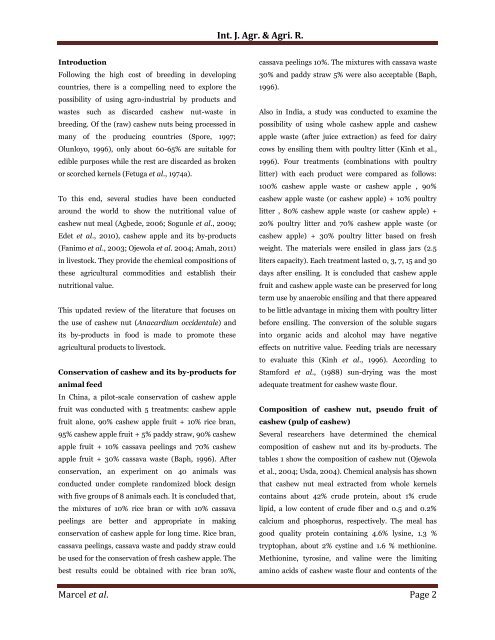Cashew in Breeding: Research synthesis
Abstract This review aims to show the research on the safe use of the cashew nut and its by-products in animal feed. They can replace corn and soy in animal diets. These investigations have involved chickens, rabbits, pigs, rats and cattle. Indeed, the cashew nuts and its by-products are rich in nutrients (carbohydrates, fats, minerals and proteins). They allow animals that eat them to make animal performances comparable to those obtained with corn and soybeans. The use of cashew nut and its by-products in livestock production is in addition to the nutritional, economic interest.
Abstract
This review aims to show the research on the safe use of the cashew nut and its by-products in animal feed. They can replace corn and soy in animal diets. These investigations have involved chickens, rabbits, pigs, rats and cattle. Indeed, the cashew nuts and its by-products are rich in nutrients (carbohydrates, fats, minerals and proteins). They allow animals that eat them to make animal performances comparable to those obtained with corn and soybeans. The use of cashew nut and its by-products in livestock production is in addition to the nutritional, economic interest.
You also want an ePaper? Increase the reach of your titles
YUMPU automatically turns print PDFs into web optimized ePapers that Google loves.
Int. J. Agr. & Agri. R.<br />
Introduction<br />
Follow<strong>in</strong>g the high cost of breed<strong>in</strong>g <strong>in</strong> develop<strong>in</strong>g<br />
countries, there is a compell<strong>in</strong>g need to explore the<br />
possibility of us<strong>in</strong>g agro-<strong>in</strong>dustrial by products and<br />
wastes such as discarded cashew nut-waste <strong>in</strong><br />
breed<strong>in</strong>g. Of the (raw) cashew nuts be<strong>in</strong>g processed <strong>in</strong><br />
many of the produc<strong>in</strong>g countries (Spore, 1997;<br />
Olunloyo, 1996), only about 60-65% are suitable for<br />
edible purposes while the rest are discarded as broken<br />
or scorched kernels (Fetuga et al., 1974a).<br />
To this end, several studies have been conducted<br />
around the world to show the nutritional value of<br />
cashew nut meal (Agbede, 2006; Sogunle et al., 2009;<br />
Edet et al., 2010), cashew apple and its by-products<br />
(Fanimo et al., 2003; Ojewola et al. 2004; Amah, 2011)<br />
<strong>in</strong> livestock. They provide the chemical compositions of<br />
these agricultural commodities and establish their<br />
nutritional value.<br />
This updated review of the literature that focuses on<br />
the use of cashew nut (Anacardium occidentale) and<br />
its by-products <strong>in</strong> food is made to promote these<br />
agricultural products to livestock.<br />
Conservation of cashew and its by-products for<br />
animal feed<br />
In Ch<strong>in</strong>a, a pilot-scale conservation of cashew apple<br />
fruit was conducted with 5 treatments: cashew apple<br />
fruit alone, 90% cashew apple fruit + 10% rice bran,<br />
95% cashew apple fruit + 5% paddy straw, 90% cashew<br />
apple fruit + 10% cassava peel<strong>in</strong>gs and 70% cashew<br />
apple fruit + 30% cassava waste (Baph, 1996). After<br />
conservation, an experiment on 40 animals was<br />
conducted under complete randomized block design<br />
with five groups of 8 animals each. It is concluded that,<br />
the mixtures of 10% rice bran or with 10% cassava<br />
peel<strong>in</strong>gs are better and appropriate <strong>in</strong> mak<strong>in</strong>g<br />
conservation of cashew apple for long time. Rice bran,<br />
cassava peel<strong>in</strong>gs, cassava waste and paddy straw could<br />
be used for the conservation of fresh cashew apple. The<br />
best results could be obta<strong>in</strong>ed with rice bran 10%,<br />
cassava peel<strong>in</strong>gs 10%. The mixtures with cassava waste<br />
30% and paddy straw 5% were also acceptable (Baph,<br />
1996).<br />
Also <strong>in</strong> India, a study was conducted to exam<strong>in</strong>e the<br />
possibility of us<strong>in</strong>g whole cashew apple and cashew<br />
apple waste (after juice extraction) as feed for dairy<br />
cows by ensil<strong>in</strong>g them with poultry litter (K<strong>in</strong>h et al.,<br />
1996). Four treatments (comb<strong>in</strong>ations with poultry<br />
litter) with each product were compared as follows:<br />
100% cashew apple waste or cashew apple , 90%<br />
cashew apple waste (or cashew apple) + 10% poultry<br />
litter , 80% cashew apple waste (or cashew apple) +<br />
20% poultry litter and 70% cashew apple waste (or<br />
cashew apple) + 30% poultry litter based on fresh<br />
weight. The materials were ensiled <strong>in</strong> glass jars (2.5<br />
liters capacity). Each treatment lasted 0, 3, 7, 15 and 30<br />
days after ensil<strong>in</strong>g. It is concluded that cashew apple<br />
fruit and cashew apple waste can be preserved for long<br />
term use by anaerobic ensil<strong>in</strong>g and that there appeared<br />
to be little advantage <strong>in</strong> mix<strong>in</strong>g them with poultry litter<br />
before ensil<strong>in</strong>g. The conversion of the soluble sugars<br />
<strong>in</strong>to organic acids and alcohol may have negative<br />
effects on nutritive value. Feed<strong>in</strong>g trials are necessary<br />
to evaluate this (K<strong>in</strong>h et al., 1996). Accord<strong>in</strong>g to<br />
Stamford et al., (1988) sun-dry<strong>in</strong>g was the most<br />
adequate treatment for cashew waste flour.<br />
Composition of cashew nut, pseudo fruit of<br />
cashew (pulp of cashew)<br />
Several researchers have determ<strong>in</strong>ed the chemical<br />
composition of cashew nut and its by-products. The<br />
tables 1 show the composition of cashew nut (Ojewola<br />
et al., 2004; Usda, 2004). Chemical analysis has shown<br />
that cashew nut meal extracted from whole kernels<br />
conta<strong>in</strong>s about 42% crude prote<strong>in</strong>, about 1% crude<br />
lipid, a low content of crude fiber and 0.5 and 0.2%<br />
calcium and phosphorus, respectively. The meal has<br />
good quality prote<strong>in</strong> conta<strong>in</strong><strong>in</strong>g 4.6% lys<strong>in</strong>e, 1.3 %<br />
tryptophan, about 2% cyst<strong>in</strong>e and 1.6 % methion<strong>in</strong>e.<br />
Methion<strong>in</strong>e, tyros<strong>in</strong>e, and val<strong>in</strong>e were the limit<strong>in</strong>g<br />
am<strong>in</strong>o acids of cashew waste flour and contents of the<br />
Marcel et al. Page 2





![Review on: impact of seed rates and method of sowing on yield and yield related traits of Teff [Eragrostis teff (Zucc.) Trotter] | IJAAR @yumpu](https://documents.yumpu.com/000/066/025/853/c0a2f1eefa2ed71422e741fbc2b37a5fd6200cb1/6b7767675149533469736965546e4c6a4e57325054773d3d/4f6e6531383245617a537a49397878747846574858513d3d.jpg?AWSAccessKeyId=AKIAICNEWSPSEKTJ5M3Q&Expires=1716562800&Signature=aYLSPmxy0dVuO2zJQuLL2gmU4h8%3D)












